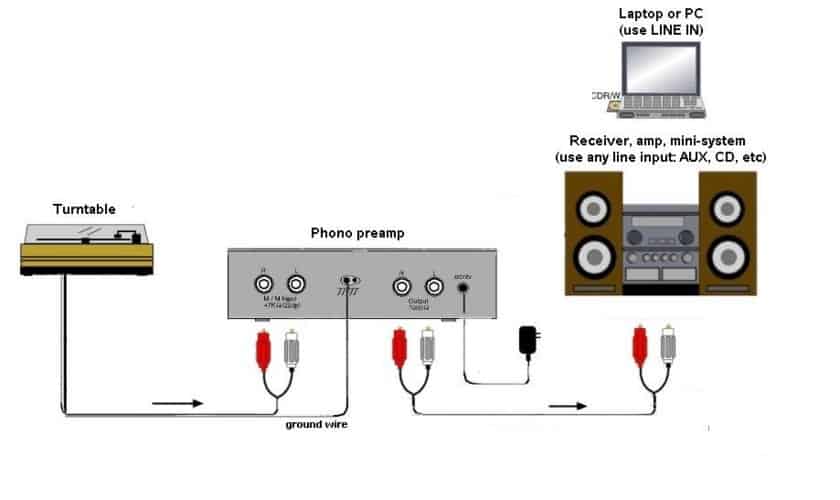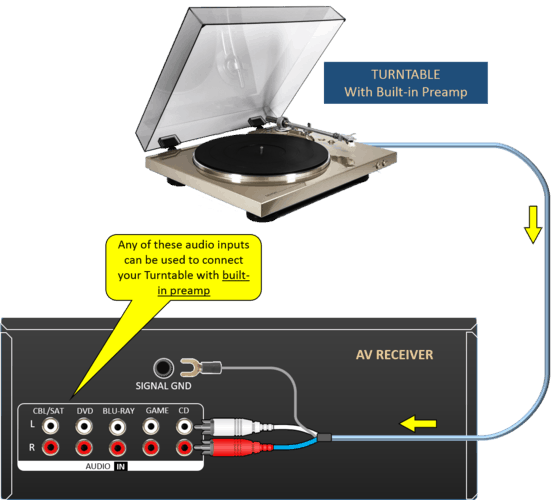Do you know what is a phono preamp? If you used turntables then certainly you would have come across phono preamps.
Before the advent of CD players and Hi-Fi stereo systems, people played music using vintage record players. This music play is also known as a phonograph/turntable. Although antique turntables are no longer manufactured commercially, you can still find modern, state-of-the-art turntables that work like a charm.
For any turntable to function properly, it requires a device that can boost its weak audio signals into standard line-level signals. This is where the phono preamp comes in.
What is a phono preamp?
In the past, phonographs (turntables) were popularly used to record and reproduce sound. This device was invented by Thomas Edison in the year 1877. Phonographs are still used to play records today – their classical sound reproduction is simply unmatched.
Turntables produce audio signals that are rather low thus requiring some high-level amplification from an amplifier. This is where the phono preamp comes in.
Before going in-depth with phono preamps, first, let us know what a preamp is?
A preamp is an electronic circuit that amplifies and boosts the weak electronic signal into the strong signal. Simply it amplifies weak signals.
Don't confuse with preamp vs amp. An Amplifier just amplifies i.e. it increases the amplitude of the signal.
Let us know the definition of a phono preamp.
A phono preamp is basically an amplifier that accurately boosts the audio signal originating from your record player.
This device goes by many names such as RIAA preamps, phono stage and turntable preamp.
Before the signal from a phonograph can be sent to the speakers, it has to undergo a series of tuning stages.
This prepares it for further amplification before the final signal is channeled to the drivers. A phono preamp handles this pre-tuning, so it's a very essential component in every turntable music player.
There are two main types of phono preamps:
- Internal preamps
- External preamps
Most advanced phonographs come with an internal phono preamp, making it incredibly easy for audiophiles to connect their systems without much stress.
Internal preamps don't need extra wiring, so there are fewer cost implications for the buyer.
However, there's one major demerit: users have zero control over how their music will sound like. External phono preamps, on the other hand, gives you unlimited control over your music.
Basics of phono preamp:
What is a phono input?
Some individuals find it hard differentiating an AUX input from a PHONO input. Basically, the latter refers to RCA connectors or mini jacks that are situated on an amplifier, mixer or preamp.
Phono inputs are popularly fitted on turntables (phonographs) and normally integrate a standardized RIAA equalization circuit.
Most stereo equipment that was commercially manufactured in the 1980s possessed phono inputs, including boomboxes.
But when latter stereo systems were redesigned, they lacked this feature – only the pricey, sophisticated receivers maintained a phono input.
Today, only a handful of stereo receivers adorn this "phono input" which is specially built to handle millivolt signals.
Phono vs line signal: how these two signals differ?

When a vinyl disc is placed onto a rotating turntable, the projecting needle (stylus) has to come into contact with it for sound to be reproduced.
This stylus translates the grooves/patterns etched into the vinyl disc, creating sound vibrations that are picked up by the diaphragm. The resultant audio signal is usually weak and is referred to as a Phono signal.
Phono signals lack the sufficient strength required to drive audio components like televisions and CD players. Therefore, they first have to be amplified to achieve more strength. The amplified signal is known as Line signal.
Some vinyl fans often wonder: how does a phono signal differ from a line signal?
- The major difference lies in the varying magnitudes of both signals: the voltage of a LINE signal (0.3V) is much stronger than that of a PHONO signal (0.005V).
- In addition, phono signals exhibit an extremely low bass level, which isn't the case with LINE signals. If you've tried using the PHONO signal on your stereo receiver's LINE input, you must have heard a strange, bass-less sound with very little volume. This behavior emanates from the phono signal's minuscule signal level.
A turntable connected to a phono preamp will deliver an output level of 0.316 Volts. But without the preamp, a turntable will produce a source output level of 0.005 Volts or lower. This signal lacks the desired power and consequently generates a sound that is barely audible.
If you're using a Moving Coil (MC) cartridge, you'll need to purchase an MC phono preamp which produces a higher amplification level compared to the MM preamp used for Moving Magnet (MM) cartridges.
Phonograph and phono stage:
In 1877, Thomas Edison created a machine that could not only record audio waveforms but also reproduce the recorded sound. He named this device the phonograph.
How does Phonograph works?

This machine works by engraving spiral grooves onto a disc or rotating cylinder. This disc with incisions, popularly known as a "record", can be rotated to recreate the etched sound. However, a needle-like component called a stylus is used to trace the incised groove patterns, regenerating the recorded audio signal (albeit very faintly).
Music enthusiasts often wonder: what's the difference between a preamp and a phono stage?
Some people use these two terms synonymously, which is inaccurate.
A phono stage is essentially a phono preamp, a device that conditions and amplifies the PHONO signal before it's sent to the main amplifier and channeled to the speakers later on.
The term "preamp" is general and can have a variety of meanings. For instance, we can talk about a microphone preamp or a speaker preamp.
A phono stage basically converts weak PHONO signals into a strong LINE signal. The resultant signal is then channeled to the DVD player or any other stereo player.
Turntable amplifiers: Internal vs external phono preamps
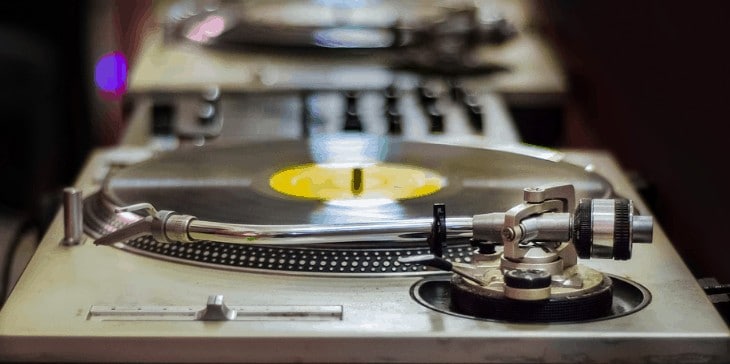
Some of the Turntable preamps or Turntable amplifiers, turntable speakers come with in-built within the turntables. For some, you need to buy external preamps. Phono preamps are usually fitted inside record players, allowing them to connect seamlessly with advanced surround systems.
These built-in phono preamplifiers are designed to convert the weak PHONO signal into a stronger LINE level output signal.
Therefore, if you own a phonograph, you already have the best phono preamp – it's conveniently built into the turntable. This makes it easy to connect an external surround system or speakers with your turntable. However, not all turntables come with inbuilt phono preamps.
Luckily, external phono preamps could provide the perfect solution. These are standalone electronic components that require a separate power supply.
The benefits of using an external phono preamp greatly outweigh the disadvantages.
- First, these devices provide sufficient protection from interference which can significantly impact the quality of your music.
- Secondly, external phono preamps don't share a power supply with the Hi-Fi amplifier, making them immune to the electrical noise that originates from the power transformer.
Although there's a vast array of external phono preamps in the market, they all perform the same basic function: amplifying the tiny microvolt signals emanating from the turntable cartridge into around 1.5 volts.
Here are the best phono preamps we prefer to use with turntables.
- Nobsound Little Bear T7 RIAA MM Turntable Preamp
- Schiit Mani Phono Preamp
- Rolls Phono Preamp
- ART DJPREII
- Puffin Phono DSP phono preamp
Turntable preamp: Built-in phono preamps
The mere mention of a "turntable" is enough to send one back to the '60s and '70s when this device was all the rage.
Thanks to the ever-increasing demand of record players in recent years, they are still manufactured today. Turntable sales figure within the United States has been gradually increasing in the past decade, with around 68,000 record players being sold in 2018.
Apparently, people still desire to hold onto those sweet memories that brightened up their lives growing up. If your family owned a record player during the old days, then you must understand how cherished that musical device was.
Today, external RIAA preamps and vinyl preamps are sold at a highly competitive price. However, we still have turntables with built-in phono preamps being sold in stores and yard sales.
An internal phono preamp has a few advantages that make it attractive. For instance, it saves on space and power consumption. It's designed to conveniently fit within a turntable, meaning that you don't need to buy extra cable connectors.
Such a magnetic phono preamp does a pretty basic job of converting weak PHONO signals into LINE level signals, but that's about it.
With an external phono preamp, you can tweak the configurations to suit your specific needs. This gives you more control over the quality of your music.
On the downside, an external stereo phono preamp requires a separate power connection and might even demand extra cables.
Today, there's a wide variety of turntables with built-in phono preamps in the market. Companies such as Sony and Audio-Technica manufacture such turntables to satisfy the growing demand.
Before buying a record player, it's important to balance excellent functionality with great value. The build quality ought to be excellent to guarantee durability. In addition, your preferred turntable ought to deliver a rich, detailed sound.
Powered speakers and built-in phono preamps
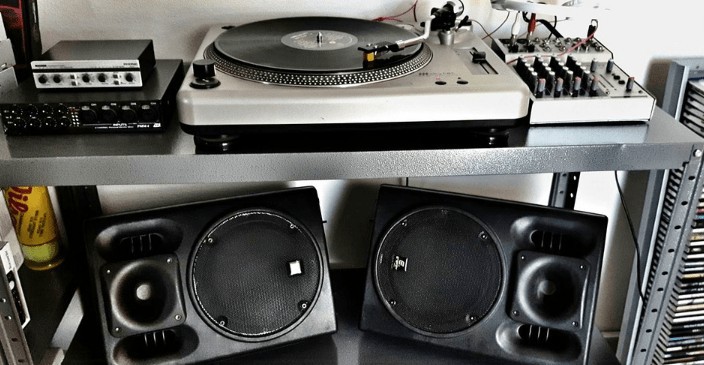
In case you use a retro turntable that doesn't possess a vinyl preamp, you'll be delighted to learn about a unique array of powered speakers that are equipped with an inbuilt phono preamp.
If you rely on ordinary speakers to power your vinyl, you'll be pleasantly surprised by the improved vinyl listening experience provided by a high-quality set of powered speakers.
Audiophiles with a distinct taste in music ought to get the right speakers that can deliver exquisite vinyl sound.
You might be wondering: why pay extra bucks to purchase a powered speaker with a built-in stereo phono preamp?
Apart from the standard 3.5mm input, these speakers also include USB and RCA inputs. Such power speakers are compatible with any type of stereo system, from computers to turntables.
They also have a compact design, allowing them to fit into tight spaces. You can easily replace your desktop speakers with a pair of power speakers to enhance your listening experience.
Unlike most desktop speakers that deliver a lot of undesired basses, power speakers that have an internal phono preamp deliver a well-rounded sound with smooth highs and a riveting bass.
The prices of such power speakers vary widely, depending on aspects such as size and available tech. therefore, it's wise to consider what exactly you need from your power speaker.
If you're tight on space, consider purchasing the compact pair of powered desktop speakers that can fit on shelves and in limited spaces.
Larger power speakers pack more power and have extra functionalities that include custom drivers and Bluetooth connectivity.
However, you'll need to fish out more money to purchase such speakers. Gladly, you can sync your turntable to these powerful speakers for an otherworldly vinyl experience.
Receivers vs amplifiers: With phono preamps
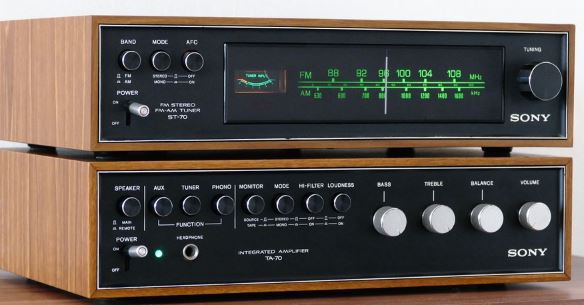
If you're a music buff who enjoys listening to good tunes, you probably utilize Hi-Fi amplifiers to improve your listening experience. Today, some amps are designed with a built-in phono stage that caters to vintage turntable users.
Basically, such power amps pick signals from the receiver, boost the signals and sends it to the speakers. But before any signal reaches the main amplifier, it must first go through a phono preamp.
Audio signals originating from the turntable cartridge are usually so weak (5 millivolts) and must first be boosted several hundred times.
Instead of having two separate amplifying devices – a phono stage and a power amp – some manufacturers have resorted to building amplifiers with inbuilt phono preamps.
Such integrated amplifiers come with several RCA inputs that permit users to connect an assortment of sources such as tuners, CD players, and recorders.
There's also a direct phono input that's meant for connecting record players. When selecting a power amp with an integrated phono stage, ensure it has a large heat sink that provides sufficient cooling for the power-hungry electronics.
However, if your power amplifier isn't equipped with an internal phono preamplifier, the best alternative would be to purchase an external phono stage that suits your particular needs.
AV receivers are normally equipped with two major components: a tuner and an amplifier.
The tuner conditions audio signals before sending them to the amplifier for boosting. Advanced stereo receivers integrate internal phono preamps that greatly enhance the signal coming from your turntable.
Depending on your budget, you can easily get high-quality stereo receivers for turntables at an affordable price. Rather than buying a separate external amplifier, it's cheaper to purchase an AV receiver with a built-in phono preamp.
Frequently asked questions
Do I need a preamp for my turntable?
Most vintage record player doesn't possess a built-in phono preamp. If you own such a turntable, then you'll definitely need to utilize a magnetic phono preamp to enhance the quality of your music.
However, if you own a modern turntable, you won't have to buy an external vinyl preamp. Advanced record players already come with inbuilt phono stages.
How important is the quality of the preamp?
Apart from receiving minuscule PHONO signals and amplifying them to LINE level signals, phono preamps handle the important task of adjusting the cartridge signal to minimize sound distortion.
Therefore, the quality of your preamp will have a huge impact on sound quality. Unfortunately, cheap phono stages produce an unsatisfactory sound quality. It's best to invest in a high-quality preamp, regardless of their expensive price.
How to hook up turntable to receiver without phono input?
If both your AV receiver and turntable don't have a built-in phono preamp, you'll need to utilize an external phono stage. This external preamp connects your turntable to your receiver. It has a variety of controls that you can tweak to your particular taste, offering more control to the user. However, you'll need to buy two extra pair of output cables.
One pair connects your turntable to the phono preamp's inputs. The second pair connects the phono stage's outputs to the receiver's line-level inputs.
Wrapping up
This is all about the Phono preamps. Throughout the ages, humans have been deeply fascinated by music. The timely invention of the phonograph allowed us to store music in record players and play it using a single, marvelous device.
Phono preamplifiers perform the vital role of boosting signals emanating from the cartridge, so it's essential to choose a good quality external phono stage to get exquisite sound from your turntable.
The information provided within this article provides essential guidelines that you can follow when selecting your next phono preamp.
Read Also: How to Fix Bluetooth Lag in Car? – 8 Super Quick Solutions


